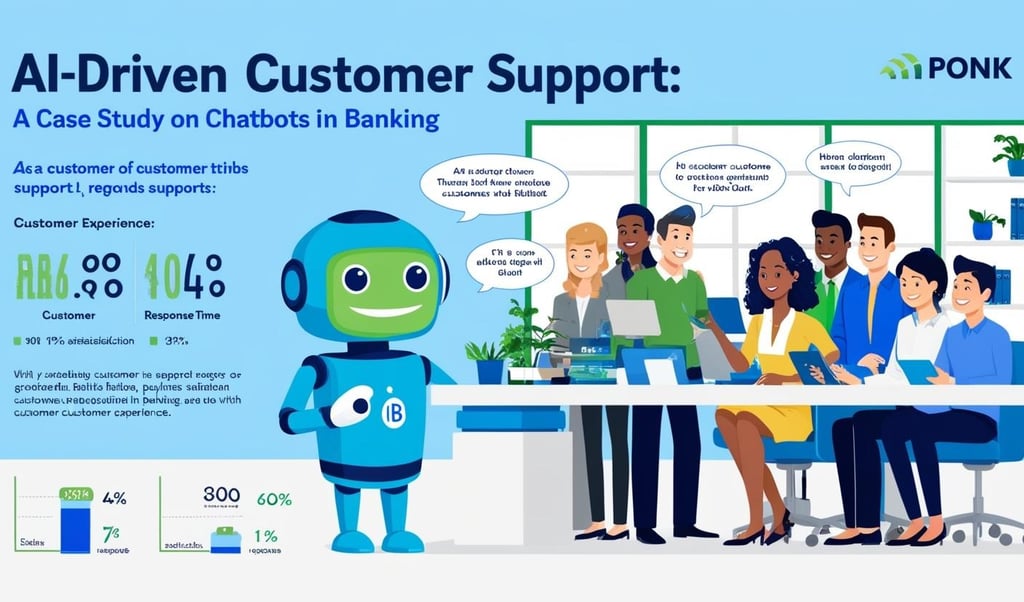AI-Driven Customer Support: A Case Study on Chatbots in Banking
Explore how a major bank integrated AI chatbots into its support system. Discuss the specific AI technologies used, their deployment process, and the measurable outcomes, such as reduced response times and improved customer satisfaction. Provide customer testimonials and data comparisons before and after implementation.
CASE STUDY


The banking industry has long been at the forefront of technological advancements, leveraging innovation to improve customer service, enhance security, and streamline operations. In recent years, artificial intelligence (AI) has emerged as a transformative force, enabling financial institutions to redefine how they interact with their customers. Among AI applications, chatbots have gained particular traction, revolutionizing customer support with their ability to provide instant, efficient, and personalized assistance.
This blog post explores the growing role of AI-driven chatbots in banking, examining their benefits, challenges, and real-world applications through an insightful case study. Whether you're a banking professional, a technology enthusiast, or an AI skeptic, this deep dive will shed light on the transformative potential of chatbots in the financial sector.
The Rise of Chatbots in Banking
Chatbots are software applications that use AI, machine learning (ML), and natural language processing (NLP) to simulate human conversations. In the banking sector, these virtual assistants have become indispensable tools for addressing customer queries, providing account information, and even executing transactions.
Key Drivers for Chatbot Adoption
1. 24/7 Availability: Traditional customer service channels are often constrained by limited hours, but chatbots operate round the clock, ensuring customers receive assistance whenever they need it.
2. Cost Efficiency: By automating routine interactions, banks can significantly reduce the cost of customer support, reallocating resources to more complex tasks.
3. Personalized Experience: Advanced chatbots leverage customer data to deliver tailored recommendations and services, enhancing satisfaction and loyalty.
4. Scalability: Unlike human agents, chatbots can handle multiple inquiries simultaneously, accommodating a growing customer base without increasing staffing requirements.
Benefits of AI Chatbots in Banking
1. Enhanced Customer Experience
AI chatbots provide instant responses to queries, eliminating the frustration of long wait times. They can also offer personalized solutions by analyzing individual customer histories and preferences.
2. Improved Efficiency
Chatbots streamline operations by automating repetitive tasks, such as password resets, account balance inquiries, and transaction histories. This allows human agents to focus on more complex issues.
3. Increased Accessibility
For customers who may not be tech-savvy or have limited access to traditional banking channels, chatbots serve as an intuitive and inclusive alternative.
4. Fraud Detection and Prevention
AI chatbots can identify suspicious activities by monitoring transaction patterns and alerting customers to potential threats in real-time.
Challenges of Implementing Chatbots in Banking
While chatbots offer numerous advantages, their implementation is not without hurdles:
1. Data Privacy Concerns: Handling sensitive financial information requires robust data security measures to prevent breaches and maintain customer trust.
2. Technical Limitations: Despite advancements, some chatbots may struggle to understand complex or ambiguous queries, leading to customer frustration.
3. Integration with Legacy Systems: Banks often rely on outdated infrastructure, which can complicate the seamless integration of AI chatbots.
4. Regulatory Compliance: Financial institutions must ensure that their chatbot solutions adhere to stringent industry regulations and standards.
Case Study: Chatbots in Banking—A Success Story
Background
ABC Bank, a leading financial institution with a customer base exceeding 10 million, faced growing challenges in managing customer inquiries. Long call center wait times and inconsistent service quality were eroding customer satisfaction. To address these issues, the bank deployed an AI-driven chatbot named "FinBot."
Implementation
1. Objectives:
- Reduce call center workload by 40%.
- Improve first-response resolution rates.
- Enhance overall customer satisfaction.
2. Technology Stack:
- Natural Language Processing (NLP) for understanding queries.
- Machine Learning algorithms for continuous improvement.
- Integration with the bank’s core banking system for real-time data access.
3. Training Data:
FinBot was trained using a comprehensive dataset of historical customer interactions, including FAQs, email transcripts, and recorded calls. This allowed the bot to learn and respond effectively to diverse queries.
Results
After a six-month pilot phase, ABC Bank reported the following outcomes:
- Reduction in Call Center Workload: FinBot successfully handled 60% of routine inquiries, freeing up human agents for complex cases.
- Faster Response Times: Average query resolution time decreased from 8 minutes to under 2 minutes.
- Increased Customer Satisfaction: Survey scores improved by 25%, with customers praising the bot’s speed and accuracy.
- Cost Savings: The bank reduced operational costs by 30%, enabling reinvestment in other digital transformation initiatives.
Customer Feedback
Customers appreciated FinBot's user-friendly interface and its ability to provide instant assistance. However, some noted limitations in handling highly specific or nuanced queries, underscoring the importance of human backup.
Future Trends in AI-Driven Banking Chatbots
1. Conversational AI
Future chatbots will leverage more advanced NLP and conversational AI techniques, enabling them to engage in more natural and meaningful interactions with customers.
2. Multilingual Support
As banks expand globally, multilingual chatbots will play a crucial role in catering to diverse customer bases.
3. Integration with Voice Assistants
The integration of chatbots with voice assistants like Alexa and Google Assistant will further enhance accessibility and convenience.
4. Proactive Engagement
AI chatbots will move from reactive to proactive, offering personalized financial advice, sending payment reminders, and suggesting relevant products based on customer behavior.
5. Blockchain Integration
With blockchain technology, chatbots can ensure more secure and transparent interactions, especially in areas like loan processing and KYC (Know Your Customer) verification.
Conclusion
AI-driven chatbots are reshaping customer support in banking, offering unparalleled efficiency, accessibility, and personalization. As seen in the case of ABC Bank, the implementation of a well-designed chatbot can yield significant benefits, from cost savings to improved customer satisfaction. However, banks must navigate challenges such as data security, regulatory compliance, and integration hurdles to fully realize the potential of this technology.
The future of banking lies in the seamless fusion of human expertise and AI innovation. By leveraging the strengths of both, financial institutions can create a customer support experience that is not only efficient but also empathetic and engaging. For those looking to stay ahead in the digital age, embracing AI chatbots is no longer optional—it’s imperative.
Explore more about the latest AI tools transforming industries at "50 Must-Have AI Tools for Professionals in Every Industry", your ultimate resource for AI insights and innovations.
Read more relevant articles: "How a Small Business Boosted Revenue by 300% with AI".

